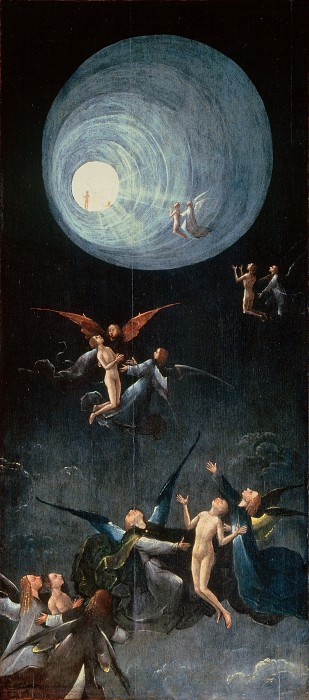The Ascent of the Blessed Hieronymus Bosch (1450-1516)
Hieronymus Bosch – The Ascent of the Blessed
Edit attribution
Download full size: 3468×7881 px (8,7 Mb)
Painter: Hieronymus Bosch
Location: Doge’s Palace, Venice (Palazzo Ducale).
The painting The Ascension of the Righteous ("Ascent to Empyrean") by the Dutch painter Hieronymus Bosch was painted in oil on board, probably in 1500-1504. The genre is religious painting. The Ascension of the Righteous was probably part of the polyptych The Blessed and the Damned. The central painting of the polyptych was "The Last Judgment," with "The Fall of the Sinners" and "Hell" on the right, and "The Ascension of the Righteous" and "Earthly Paradise" on the left. The subject was inspired by the idea of the end of the world, the prophecy of which had spread in Western Europe by the beginning of the 16th century.
Description of Hieronymus Bosch’s painting The Ascension of the Righteous
The painting The Ascension of the Righteous ("Ascent to Empyrean") by the Dutch painter Hieronymus Bosch was painted in oil on board, probably in 1500-1504.
The genre is religious painting.
The Ascension of the Righteous was probably part of the polyptych The Blessed and the Damned. The central painting of the polyptych was "The Last Judgment," with "The Fall of the Sinners" and "Hell" on the right, and "The Ascension of the Righteous" and "Earthly Paradise" on the left.
The subject was inspired by the idea of the end of the world, the prophecy of which had spread in Western Europe by the beginning of the 16th century. The artist usually painted gluttonous men boiling in cauldrons of molten coin, and gluttons eating toads and snakes. However, in the work The Rapture of the Righteous there is no torment of sinners, it is filled with a luminous mood. Accompanied by angels, the righteous, who have rid themselves of earthly cares and problems, fly through a deep tunnel filled with unearthly light. Their countenances are turned toward the bright glow pouring down the corridor. Their hands are frozen in supplication. The figures become weightless, take off easily, and reach the end of the tunnel, where they become incorporeal, lose themselves, and merge forever with God.
И. Bosch makes a masterful use of light, which helps to create the main plot. Light leads the viewer from the illuminated clouds to the human figures scattered around the painting and finally to the tunnel. The shimmering of light and darkness, the hues and saturation of colors help the author convey depth and volume. This is most clearly seen in the depiction of clouds and the tunnel.
To convey perspective the artist draws the people in the foreground larger and those further away smaller. The rings of the tunnel perfectly convey the effect of movement.
Calmness and tranquility fill the picture, the heroes have nothing to worry about, their journey is almost complete. And yet there is tension in the work, created by the red and black pointed wings of angels.
The work is kept in the Doge’s Palace, Venice.
Кому понравилось
Пожалуйста, подождите
На эту операцию может потребоваться несколько секунд.
Информация появится в новом окне,
если открытие новых окон не запрещено в настройках вашего браузера.
You need to login
Для работы с коллекциями – пожалуйста, войдите в аккаунт (open in new window).




















COMMENTS: 2 Ответы
Это художник был большой фантазер. Но чтобы это всё понять, надо знать мифологический сюжет.
Человек в 15 веке, за 500 лет до первых опытов реанимации и рассказов переживших клиническую смерть, буквально мистически предвидел туннель со светом в конце. В картинах Босха всегда было что-то, выше сюжета...
You cannot comment Why?
The painting depicts a scene of souls ascending towards a bright, circular portal in the heavens, guided by angels. The composition is dramatic, with figures in various states of movement and emotion.
What I see:
Subtexts:
The painting, The Ascent of the Blessed, is rich in symbolism, inviting viewers to contemplate themes of faith, judgment, and the ultimate destiny of the soul.